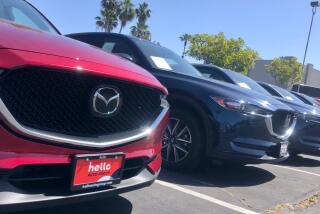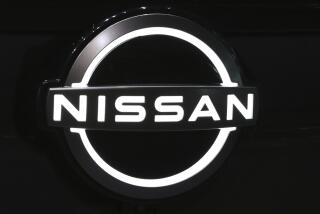GREEN LIGHT FOR AIR BAGS : After 20 years of delays, millions of 1990 models will be equipped with the devices. Experts say the wait was worth it.
- Share via
DETROIT — An air bag is as loud as a shotgun when it explodes in your face, but you almost never hear it when it goes off.
That’s because you’re too busy having an accident.
Metal grinding against metal is much louder.
Later, after you walk away from the wreck, you might notice bruises on your arms, too. Air bags hit the driver hard when they blow out of the center of the steering wheel.
But when air bags finally start to become more commonplace on new cars next fall, drivers all over America--drivers like Melanie Stephenson--will surely be glad to trade the bruises for their lives.
Three years ago, the Connecticut insurance saleswoman skidded around a corner in her 1985 Ford Tempo--a company car fitted one month earlier with an air bag as part of an experiment--and found herself staring straight into an oncoming propane truck.
“I hit the truck--we were both going about 30 miles an hour--and the car bounced off,” she remembered with a shudder. “I closed my eyes. I didn’t want to see what was happening.
“Then when I opened them, the air bag was there. It comes out really hard, but it was still like falling into a cushion.
“I didn’t hear the air bag, you black it out and hear the accident. Later, I saw an air bag tested, and I was surprised at the noise because I absolutely hadn’t heard it in my crash.”
Her car was shredded steel. Rescue workers had to pry it open to get her out.
But besides severe bruises to her knees, which rammed into the dash, Stephenson was unhurt.
“The police were completely surprised that I survived,” said Stephenson. “I’m sure without the combination of my seat belt and air bag, I’d be dead right now. I think the combination of the two saved my life.”
Later this year, millions of Americans will begin to understand for themselves what Stephenson is talking about.
Twenty years late.
Way back in July, 1969, then-Secretary of Transportation John A. Volpe proposed a federal rule calling for all new cars and trucks to come equipped with “inflatable restraints” as soon as possible.
Finally in the fall of 1989, just in time for the 1990 model year, air bags will be installed on American cars in big numbers for the first time: 3 million to start and more to follow.
But over those long years since Volpe’s announcement, the air bag became the focus of one of the longest-running regulatory battles in modern American history, a bitter case of political gridlock handed down through scores of government officials, auto and insurance industry executives and consumer advocates.
It was a tiresome fight that had only one result--keeping air bags off the market and out of American cars for an entire generation.
Often, the goal of improved auto safety seemed to get lost in the shuffle, as the competing sides repeatedly refused to compromise. “No one could put the two sides together,” sighs Helen Petrauskas, a Ford vice president in charge of safety matters.
It was a standoff that many involved thought would never end.
“Air bags, air bags,” Chrysler Chairman Lee A. Iacocca once joked at a press conference. “People have been asking me about air bags for 20 years. I think when I die and go to heaven, I’m going to get to the Pearly Gates, and St. Peter is going to ask me, ‘Lee, what about air bags?’ ”
But now, the battle is over. Thanks to a 1984 compromise hammered out by then-Secretary of Transportation Elizabeth Hanford Dole--allowing auto makers to gradually phase in the restraint systems over several years--air bags are on the way.
Beginning in the 1990 model year, all passenger cars sold in the United States must, by federal law, be equipped with “passive restraint” systems--either air bags combined with existing manual seat belts or automatic “motorized” seat belts.
Most auto industry experts now believe that consumers will prefer air bags over automatic seat belts, which envelop passengers as soon as they get in a car. Many drivers thus find automatic belts more annoying than air bags, which are stored away until an accident. In fact, some car makers may soon begin advertising the fact that their cars have air bags rather than automatic belts.
Still, air bags are more expensive, so it will be easier for auto makers to justify their price--currently more than $800--on larger cars, while automatic belts will mostly be installed on cheaper subcompacts. That’s why Mercedes-Benz was the first to offer air bags on its luxury models in the early ‘80s and why General Motors is offering air bags first on selected Oldsmobile and Cadillac models and Honda on its upscale Acura Legend.
But by next year, air bag-equipped cars won’t be hard to find. Industry officials predict that 3 million cars will have air bags for drivers in 1990, up from just 400,000 this year, under the government’s rule that has allowed auto makers to phase in passive restraint systems gradually since 1987. The year after next the number is expected to grow to 5 million.
Air bags will be even more common by the mid-1990s, when passenger-side air bags will be required as well. Air bag manufacturers will then be expanding, and prices should come down to about $300. As a result, air bags could start to squeeze automatic seat belts out of the market, industry officials predict.
“The direction the industry seems to be going is significantly more air bags in the future,” notes Bruce Henderson, vice president for planning for the air bag division of Cleveland-based TRW.
Greater acceptance of air bags has come on the heels of increased health awareness across the nation, a trend that has played a major role in convincing auto makers to finally back air bags after years of opposition. Ford said its surveys show that safety is now consistently ranked right behind quality as the second most important buying consideration for customers today; 15 years ago, it wasn’t even among the top 10 factors.
As a result, auto executives who once dismissed air bags by arguing that safety didn’t sell now say it does.
“Our society is more fitness- and health-oriented, and that is making safety a more important criteria,” said Larry Parker, Chrysler’s chief engineer for vehicle safety.
Dramatic technological improvements that have made air bags less obtrusive and more reliable have also helped win over the industry, as well as drivers who have tried them.
Today, air bag systems only weigh about three pounds and are just seven inches long, fitting directly into the center of a steering wheel; early air bags in the ‘70s weighed several times as much and blocked the driver’s view of the dashboard.
Lots of False Starts
The air bags now on the road are also working without many hitches. Chrysler, which has just started offering air bags on six models, notes that of the 120,000 cars with air bags it has sold, it knows of 175 air bag deployments during accidents. Chrysler said the bags have all inflated properly and the company said it knows of no instance when the bags went off by mistake.
Now, air bag manufacturers, after enduring years of false starts, are suddenly scrambling to build factories and hire thousands of workers to meet the rush of demand.
“I think within two years, air bags will be a billion-dollar industry,” said Ken Holmgren, general manager of the automotive products division of Morton Thiokol, a Utah-based producer of air bag components.
Federal regulators, meanwhile, still believe that thousands of lives will be saved when air bags finally arrive in big numbers.
“I think it has been worth the wait,” said Barry Felrice, associate administrator for rule making at the National Highway Traffic Safety Administration. “We’re still very optimistic that air bags are going to have significant safety benefits for the public.” In fact, the government estimated in 1984 that as many as 9,000 lives could be saved each year if all cars had air bags for front-seat occupants.
So, for the first time in 20 years, the air bag is no longer a political football and instead is about to become a realistic safety device. “On the whole, we don’t hear any more grumbling,” from pro-air bag advocates or the auto industry, noted Felrice. “The (air bag) rule’s going into effect, everyone’s happy . . . everyone’s bitter that it didn’t happen 10 years ago . . . but everyone’s leaving it alone. And there are no more lawsuits.
“Air bags are coming.”
But they have been coming for an awfully long time, and the main combatants in the air bag struggle are still not on speaking terms. Safety advocates and auto executives still cast blame upon each other for fouling up the seemingly endless regulatory process.
Lost the War
“The main reason it took so long to get air bags was simply that the (auto) industry opposed them,” stated Joan Claybrook, former administrator of the National Highway Traffic Safety Administration in the Carter Administration and currently head of Public Citizen, a Ralph Nader-backed consumer group.
“The auto companies waged the regulatory equivalent of war against the air bag and lost,” added Clarence Ditlow, director of the Center for Auto Safety, another Nader-backed group. “We literally lost 150,000 lives because of their opposition.”
“If they (consumer advocates) had had their way, they would have forced technology on the American public before it was ready, and it could have resulted in systems that caused harm,” responded Parker of Chrysler.
Ironically, this long war started with America’s leading auto maker--and later the air bag’s biggest foe--actually acting as the air bag’s greatest backer.
In the late ‘60s, with highway deaths hitting record levels, General Motors President Edward N. Cole, an engineer by trade, became an ardent supporter of the emerging air bag technology.
Cole pushed GM engineers to work closely with federal regulators on air bag research, and by 1970 promised that GM would voluntarily offer air bags on all of its cars by the fall of 1974, in time for the 1975 model year.
“GM was then the leader in air bag development,” noted John Graham, a public health professor at Harvard and the author of a new book on the history of the air bag.
But Ford, the second-largest auto maker, was staunchly opposed to air bags, and in 1971 Henry Ford II and then-Ford President Lee A. Iacocca secretly met with President Nixon--in a session later revealed by the release of the Nixon White House tapes--and convinced him to delay the new, GM-backed safety standards on air bags by two years, until 1975.
GM Represented Industry
As Ford won delays, GM was also having a change of heart. When Cole, the only top-level air bag advocate in Detroit, retired at the end of 1974, GM’s new management turned against air bags. GM virtually killed off its own air bag test program by reducing the number of cars involved and by doing little to market them. For years afterward, GM pointed to the poor sales of its mid-1970s air bag-equipped cars as proof that consumers didn’t want them.
“When GM turned against air bags, that meant the whole industry was against them,” observed Graham.
But just as the auto industry was uniting against government regulation, safety advocates were becoming increasingly committed to air bags.
Graham and other observers argue that some, like Claybrook, a Nader protege who took over as chief regulator of highway safety in the Carter Administration, became obsessed by air bags, blind to compromise and possible alternatives. “Claybrook came with a mission, and she felt her mission was air bags,” said Graham.
Deep suspicions developed on all sides, and negotiations became almost impossible. The result was further fighting and delays.
Claybrook argues, however that compromise was impossible with the auto industry, which only wanted to delay air bags as long as possible. “We did reach out” to compromise, Claybrook said. “To search for errors in the regulatory process is silly because it worked. The industry just delayed.”
Still, it wasn’t until 1984--after the Reagan Administration killed air bags and a Supreme Court ruling revived them again--that a Dole’s final compromise was hashed out, giving the industry time to phase air bags in over several years.
The compromise came just as consumer interest in health and safety was increasing; soon, the industry recognized that air bags were inevitable. Ford became the first domestic company to commit to air bags.
“Literally, within days of Dole’s (compromise) decision, we decided passive restraints were here,” said Ford’s Petrauskas.
Now that it is over, those involved are starting to look for lessons to be learned from 20 years of waiting for air bags.
“I think the need to build consensus is what I take away from this,” said Felrice of the federal highway safety agency. “If you don’t have that consensus . . . it’s going to drag on. . . . It becomes hard to accomplish anything.”






